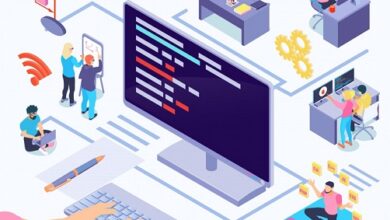HR department functions/Role of HR
What does HR mean?
HR is the acronym that abbreviates the word “Human Resources”, that is, the set of employees of an organization. In this article we will provide you the information about functions of HR department.
Thus, the basis of the responsible sector are the functions of recruitment, selection, training, remuneration and benefits for workers.
The Human Resources area emerged with the first industrial revolution, when it did not have a strategic positioning and was limited to ensuring compliance with the decisions of the bosses.
With the arrival of labor laws and the change in society‘s attitude towards labor relations, HR underwent a major transformation, taking on the responsibility of ensuring good professional relations, seeing the employee as an important part of the company’s assets .
What is Human Resource Management?
Human Resource Management is a set of techniques, skills and strategies used to provide employee satisfaction and, at the same time, help the company achieve its goals.
In general, human resources management aims to be the mediating area between the organization and the employees, so that both have their interests achieved and develop an advantageous relationship.
We can, then, understand that the Human Resources of a company are the employees, the Human Resources sector is the area responsible for managing these employees and Human Resources Management refers to a strategic function within HR.
What does the Human Resources area do?
There are several attributions of Human Resources, and every day they have become more important in organizations. Tools that were little used before, such as climate research and behavioral management, began to gain importance with the development of human relations theory in the 1930s.
Here are the HR functions:
1. Recruitment and selection
The results achieved by an organization depend on the availability of competent and productive work teams. Thus, the process of recruiting and selecting personnel is a primary occupation.
Attracting the right talent, planning efficient selection processes and ensuring that the company hires the most aligned with its purposes and culture… all of this influences the results that will be generated by the company, having a great impact on costs and profits.
The ROI of new hires is the metric used to indicate the financial impact that a new employee has on the company, if all the investment made during the selection process and its admission had a positive or negative result for the financial sector.
From the moment that HR uses this resource, it is possible to know if the process is resulting in profit or loss for the organization, which impacts the management of other leaders, who will think very carefully before requesting a collaborator for their sector.
2. Definition of positions and salaries
This sector is responsible for defining the company’s positions , describing and specifying each one of them, in order to ensure that salaries are compatible with the roles and responsibility – creating a basis for recruiters to efficiently describe the vacancies to be advertised.
This description is part of a process that is automatically linked to the performance evaluation , because if a certain task is not specified in the employee’s role and he/she performs it routinely, an analysis must be made and adjusted as necessary.
HR cannot relax even when the entire job description and salary table is finalized. It’s important to maintain a role review frequency so you don’t have problems passing the audit.
3. Personal and corporate development
Personal development includes activities that enhance worker awareness and identity, as well as promote the development of personal skills and potential .
In this way, it contributes to the construction of the organization’s human capital, improving the quality of life and contributing to the realization of dreams and aspirations. Thus, it is also possible to develop more engaged and motivated teams , achieving the best results.
When HR sees the employee as an individual, it is able to extract the best and points to improve from each employee.
Leadership is a fundamental part of this process, as it participates in the day to day of the person being led, but this is when we talk about a participatory leader, who knows each person on his team deeply and easily identifies their strengths and weaknesses.
Personal development is a consequence of the person ‘s evolution, as everyone shows signs of growth and also a drop in income and the manager needs to be alert to act before the professional loses motivation or resigns for lack of encouragement.
By investing in employee growth, teams are automatically stimulated, as everyone will be level in their knowledge and this activates interpersonal relationships, participation in proposed activities, engagement and increases the productivity of the team that will achieve better results.
4. Performance Management
With the high degree of strategic importance that HR has acquired in recent years and technological innovation, it has become much easier to measure productivity according to the organization’s goals and achieve better results.
This performance evaluation management is responsible for defining the KPIs responsible for controlling performance in the processes and measuring the efficiency of employees so that everyone is level and produces with the same efficiency.
As KPIs are performance indicators , results are obtained during the process, which gives leaders almost real-time numbers of everything that happens during the activity, immediately pointing out if there is any error and drop in performance, including where and who was responsible.
This management should not be treated as a punitive action, but as a stimulus for really engaged professionals to have the same commitment and unite so that all the work is carried out correctly and the goals are achieved.
Performance management is important for the alignment of information and effective communication of all the company’s strategies, as not only the leaders will be responsible for dealing with the achievement of goals , the entire team will be aware that they have their share in the business success.
For performance management to achieve the expected success, it is important that the organization’s goals are clear and Human Resources also have an aligned performance management, to build a fair and stimulating reward policy for employees with transparent rules and communication.
5. Training
Training can be technical , with the objective of teaching specific tasks to be performed, and also integration , with the aim of helping new employees adapt to the environment and the work team.
From the performance management, it is possible to visualize the difficulties in the productive process of the collaborators and define what type of technical training needs to be applied.
Just as, in case of difficulties in relationships, leaders need to point out the needs to develop talent and help them adapt to the work environment and team.
At the time of hiring, introductory training is necessary for the new hire to feel effectively part of the company, knowing even more the mission, values and organizational culture.
It is from this training that the employee begins to formulate his opinion about the company and to actively participate in the activities.
Today, training can be done through e-learning , using technological resources and even games — with the aim of holding the employee’s attention and encouraging him to participate in the processes.
6. Benefits Policy
Here, the rights and benefits of employees are managed. It is a fundamental part of the relationship between company and employee, directly influencing the satisfaction and quality of life of employees.
When workers are injured or people with disabilities are unable to work, they often turn to compensation and benefit systems for the income and other support they need to deal with the physical, emotional and financial consequences of the injury or illness.
The Human Resources sector also helps in the search for these benefits.
7. Monitoring metrics and strategies
A big advantage of modern HR is the ability to manage data , which makes processes much more efficient.
Through modern software , such as Gupy , it is possible to analyze and monitor management processes from recruitment, making decisions and obtaining more accurate results.
8. Provision of human resources
It is the responsibility of the Human Resources area to provide human capital to the organization, in order to guarantee its perfect functioning, as well as productivity and good results.
Fulfilling this action involves the processes of recruitment, selection, hiring , training and retention of personnel for the routines and demands of the company.
9. Personnel department
The personnel department carries out all the bureaucratic routines of the sector, generating, taking care of and distributing all types of documents necessary for personnel administration — from hiring to dismissal.
What is the role of HR?
The Human Resources area is essentially services. Their functions vary according to the type of organization to which they belong, always aiming at the effective integration of all departments in search of the best results . Among its essential functions, we can highlight:
- assist and provide services to the organization, its leaders, managers and employees;
- describe the responsibilities that define each position and the qualities that the person who occupies it must have;
- assess team performance and promote leadership development;
- recruit the right staff for each position;
- train and develop programs, courses and any activity in order to improve the knowledge of the staff;
- provide psychological help to its employees in order to maintain harmony between them — in addition to finding a solution to problems that arise on a daily basis;
- establish and control employee benefits ;
- distribute new or revised company policies and procedures to all employees through newsletters, meetings, memos or personal contacts;
- take care of the safety, health and quality of life of workers;
- ensuring diversity in the workplace — this allows the company to succeed in different national and global markets.




